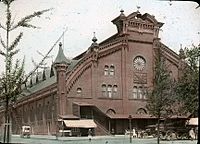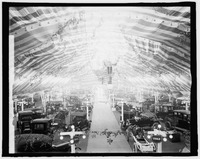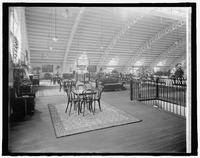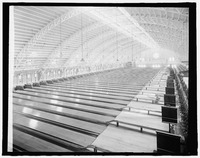Northern Liberty Market facts for kids
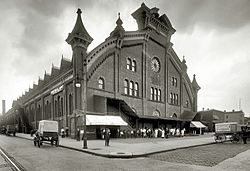
Northern Liberty Market
|
|
| Location | 5th Street NW, between K and L |
|---|---|
| Coordinates | 38°54′10″N 77°01′07″W / 38.90290639999999°N 77.01866129999996°W |
| Opening date | 1874 |
| Closing date | 1963 |
| Architect | James H. McGill |
The Northern Liberty Market was a busy place where people bought and sold goods in Washington, D.C. It was also known as the Convention Hall Market and later the Center Market. This market was located on 5th Street NW, between K and L streets. It served the city for many years, from 1875 until it closed in 1963.
Contents
History of the Northern Liberty Market
Old Market at Mount Vernon Square
The first Northern Liberty Market was at Mount Vernon Square. This area was one of the busiest parts of Washington, D.C. The market here was made up of old, worn-out sheds.
In 1871, President Ulysses Grant ordered the market to be torn down. His goal was to create a public park. This park later became the site of the Carnegie Library in 1903.
Governor Alexander Shepherd was in charge of tearing down the market. When the sellers found out, they tried to stop him in court. But Governor Shepherd moved quickly. The market was guarded by armed men, like a fort.
One night, Governor Shepherd arrived with many men and torches. By morning, the market was completely gone.
Many sellers asked for money because their market was destroyed. The District of Columbia was not held responsible. Instead, Governor Shepherd was found responsible. However, Congress later agreed to pay the sellers. In 1899, after many years, money was finally paid to the few sellers who were still alive or to their families.
Building the New Market (5th Street and K Street NW)
A new Northern Liberty Market was built in 1874. It was located on K Street NW, a few blocks from the old market. This new market was built on land that cost $100,000. The building itself cost $150,000 to construct.
The architect for the new market was James H. McGill. The building was about 324 feet (99 m) long and 126 feet (38 m) wide. It was 35 feet (11 m) high on the sides and 85 feet (26 m) high in the middle.
The ground was marshy, so the foundations were built deep into the earth. The walls were made of red bricks. The roof was made of wrought iron and weighed 209 tons.
Many sellers from the old market moved to this new location. The new market opened in January 1875. It was managed by a group called the Northern Liberty Company.
In 1885, a legal case about the market went all the way to the Supreme Court of the United States. The case was about a seller who had a very long lease for a stall. The market company's own existence was for a shorter time, which caused a conflict.
The Convention Hall Above the Market
In 1887, people started talking about building a large hall above the market. Construction began in 1891. On May 22, 1893, the Convention Hall officially opened. It was also called the Northern Liberty Auditorium.
The Convention Hall was used for many different activities. It hosted silent movie showings, religious meetings, and even a roller skating rink. It was also a place for food shows, car shows, and dog shows. High school graduations and events for the DC National Guard also took place there.
In 1912, a big celebration for the unveiling of the Columbus Fountain included a banquet and concert at the Convention Hall. It was one of the largest venues in the city at that time.
Later, in the 1920s or 1930s, the Hall became a bowling alley. It was destroyed in 1946.
In 1931, the market below was renamed Center Market. This happened after the original Center Market building was torn down. Many sellers from the old Center Market moved to this smaller market.
The Fire of 1946
On March 1, 1946, a fire destroyed the top floor of the building where Convention Hall was. Fire alarms went off five times. The first alarm was at 1:51 am. Large flames quickly spread through the metal structure.
At 2:09 am, the heavy wrought iron roof, weighing 209 tons, collapsed. Over 60 fire trucks and other equipment fought the fire. It was finally put out by 3:30 am, but water continued to be used until morning. The fire marshal said the high roof and materials in the bowling alley helped the fire spread fast.
The fire did not reach the market below because of a strong concrete ceiling. However, many products were damaged by the large amounts of water used. About 70 butcher, grocery, and flower stalls were affected. One stall was crushed by a falling iron beam.
The next morning, the manager of the Washington Convention Hall Company said they hoped to turn the building into a one-story market. He estimated the damage to be $800,000. For safety, a part of the wall on 5th Street NW was torn down the next day.
The merchants hoped to reopen the market within two weeks. Health inspectors checked the meats to make sure they were safe to eat. The power had been cut, so the refrigerators were not working for several days.
Reopening and Closing
The market did reopen, but with a flat roof instead of the old high one. Leo and Norman Bernstein bought the property after the fire. It reopened only as a market, without the hall above.
The market finally closed in 1963. By then, only 110 stalls were occupied. Supermarkets were becoming more popular, which made it hard for the market to compete.
After the market closed, the National Historical Wax Museum moved into the building in 1964. The museum later moved again in 1975. The empty building was finally torn down in 1985.
Present Day
Today, the site of the Northern Liberty Market is home to the CityVista condominiums. There is a Safeway supermarket and other businesses on the ground floor. The site is recognized as a historic place in D.C.
Images for kids


